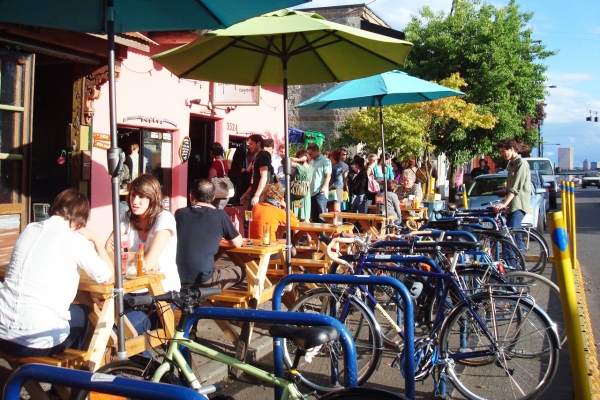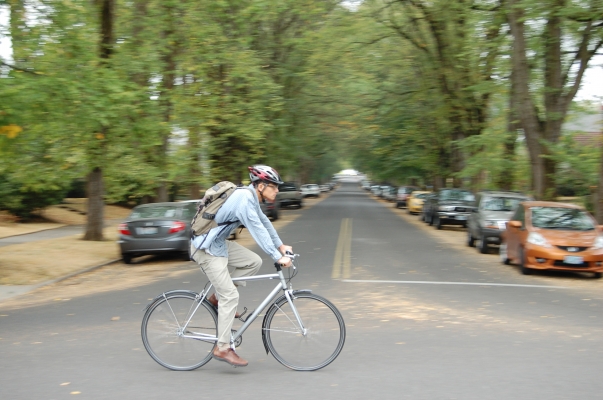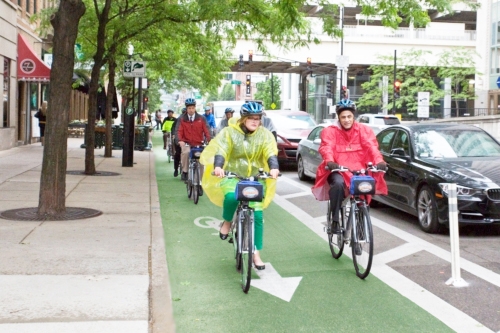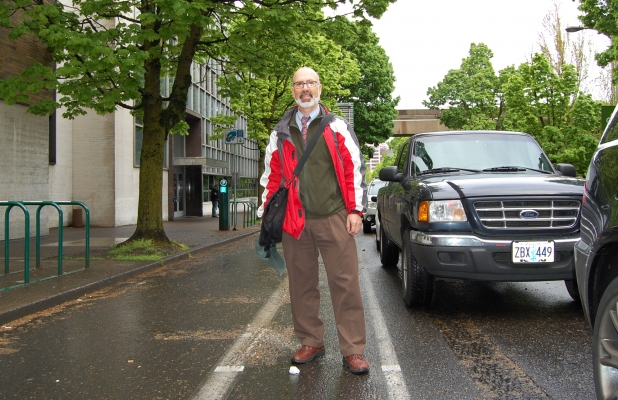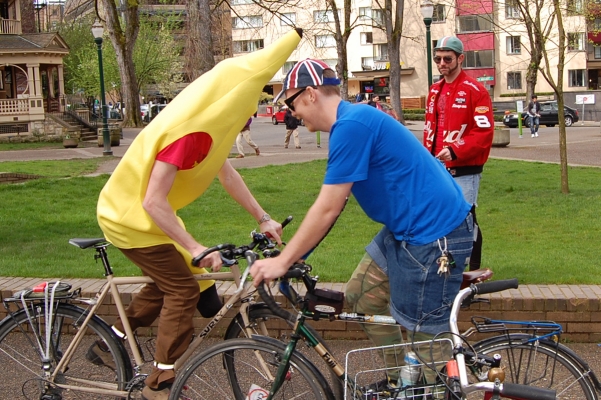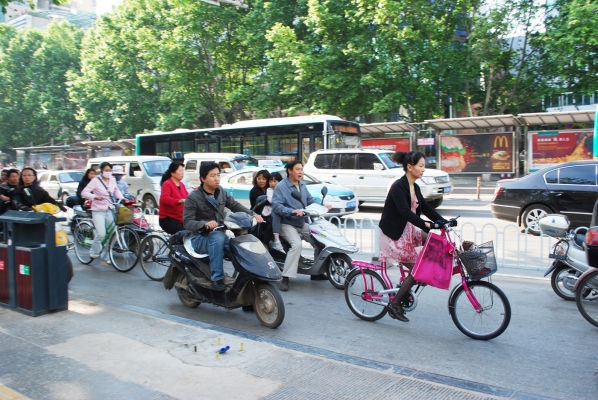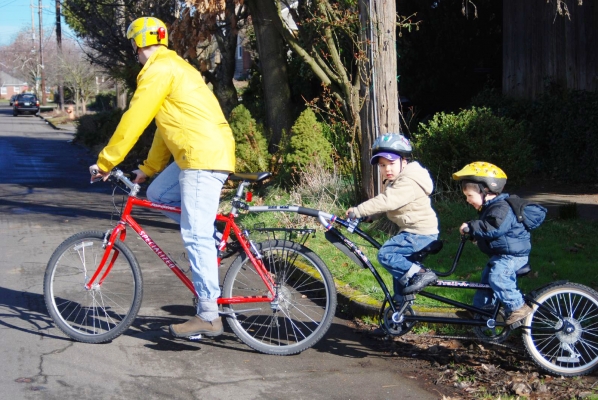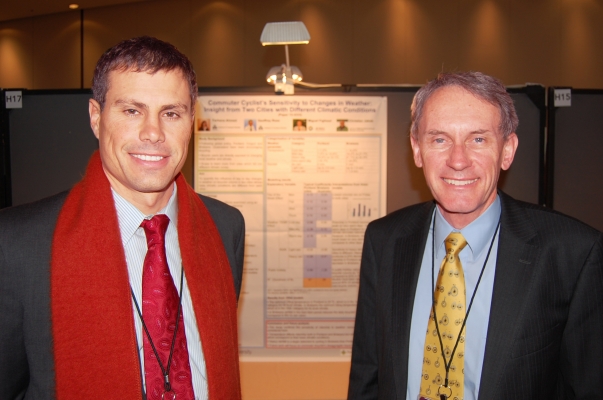This fall, the Friday transportation seminar series at Portland State University has focused on data collection and how information is used to make transportation investments. The Oct. 26 seminar, with the University of Minnesota’s Greg Lindsey, covered tracking and modeling travel behavior.
Engineers and planners alike have relied on traffic counts for their traffic models, but data behind bike and pedestrian travel has been fuzzy. Now, researchers such as Lindsey are offering new methods for conducting bike and pedestrian counts on trails and multiuse paths.
With little guidance from the Federal Highway Administration, Lindsey said, most of the efforts in creating best practices have bubbled up from communities like the Twin Cities, chosen as Nonmotorized Transportation Pilot Cities. Lindsey and his researchers monitored six trails in Minneapolis, using inductive loops and infrared beams.
To address calibration problems and offer validity to their field numbers, Lindsey also sent students into the field to verify counts. The technology allowed for finer-grained detail, especially over a 24-hour period. OTREC Director Jennifer Dill noted, “Too much in the past we’ve lumped “bike and peds” together and your work and analysis is demonstrating that they truly are different modes, with different behaviors.”
Lindsey stressed the importance of conducting this type of research, and measuring our “bicycle miles traveled” and “pedestrian miles traveled” in...
Read moreWhen policymakers look to meet cycling goals by investing in new bicycle routes, they have little research to help them determine whether cyclists will actually use them. As a result, bicycle facilities aren’t considered equally with motor vehicle infrastructure.
That’s changing, thanks in part to OTREC research. An OTREC-funded study, the first to gather large-scale data that reveal cyclists’ actual route preference, is being published in a scientific journal (Transportation Research Part A). The findings have already been incorporated into the regional travel demand model used to make transportation investment decisions across the Portland region.
In the study, Portland State University researchers Joseph Broach, Jennifer Dill and John Gliebe (Gliebe is now with RSG Inc.) outfitted cyclists with GPS units to record which routes they chose and model the choices to reveal preferences. Previous studies have relied on stated preference surveys or less reliable methods of determining cyclists’ actual routes. The data gathering was supported by a grant from the Robert Wood Johnson Foundation through its national...
Read moreOTREC has selected its first roster of projects under the new National Institute for Transportation and Communities, or NITC, program. The program’s executive committee chose 19 projects, totaling $1.97 million, under the NITC theme of safe, healthy and sustainable transportation to foster livable communities.
The projects have national implications and reflect priority areas including public health, equity and transit. True to the program’s multidisciplinary nature, projects extend beyond transportation engineering and planning to include sociology, chemistry, economics and more—10 disciplines in all.
While Portland State University, the University of Oregon and the Oregon Institute...
Read moreA project to create more miles of protected bike lanes in American cities, which launched this week, turned to OTREC researchers for the project’s research component. The Green Lane Project invited the researchers to Chicago for the project launch.
The Green Lane Project, a project of the Bikes Belong Foundation, chose six cities to serve as pilot sites for new designs and approaches to creating comfortable, separated bike routes such as cycle tracks, which may or may not be painted green. Being part of the project will enable the cities to share their experiences, get help with communication and coordinate with federal, state and local agencies.
The six cities are Austin, Texas; Chicago; Memphis, Tenn.; Portland, Ore.; San Fransicso; and Washington, D.C.
Portland State University researchers Chris Monsere, Kelly Clifton and OTREC Director Jennifer Dill went to Chicago for the launch and to meet potential research partners. They shared their research approach with representatives from the six cities.
After performing similar evaluations of bicycle facilities in Portland and Washington, D.C., the Portland State researchers are proposing to fine-tune and apply their methodology to the six project cities. The team would assess the safety, operations economic effects,...
Read moreWhen Peter Furth returned from a sabbatical in the Netherlands inspired to make his home country as bike-friendly, he knew he’d encounter bicycle skeptics. What surprised him was the resistance he got from bicycle supporters.
Furth , a professor at Northeastern University and an OTREC visiting scholar, shared some of his research on low-stress bicycle networks in a talk May 4 at Portland State University. Click here for more information.
Even in recent years, bicycling advocacy organizations were dominated by followers John Forester’s concept of “vehicular cycling,” Furth said, and opposed to separated bicycle facilities. Cyclists should use the road, and be treated, like any other vehicle operators, according to this reasoning.
“People get an idea of what utopia is,” Furth said, “and their idea is just bikes operating like any other vehicle. The crazy thing is, it’s an experiment that has been lived out every day for the last 50 years. You can go out and do it today. It just doesn’t work. It’s just nutty.”
European cities have carried out their own massive experiment for decades as well, Furth said. “Millions of people every day are riding on separated facilities, and what is the outcome? Huge numbers of people riding: children, old people, men and women in equal numbers, and the bike fatality rate is 10 times lower than...
Read moreStudents in Transportation Engineering and Planning, the OTREC-funded transportation student group at Portland State University, held its biggest-ever Urban Olympics, the annual celebration of Portland’s quirks and oddities. The 2012 games, held in April, featured participation from planning, engineering and public health departments.
Teams competed in games such as Urban NASCAR, which included slow-biking and gummy worm-eating components, and the noncopyright-infringing “Astonishing Rush” scavenger hunt. The first-year master of urban and regional planning, or MURP, students took the participation award, with 16 competitors, while the best department award went to the second-year MURPs.
The best team award went to Team Jellis, composed of Jamie Jones and Scotty Ellis. More awards are at the STEP website.
Photos are after the jump.
Photos:
For rapid transportation mode-share changes, it’s hard to beat Kunming, China, where OTREC Director Jennifer Dill is visiting this week. In recent years, car and transit trips have quadrupled. Bicycling, which used to account for more than half of trips, now makes up less than a quarter.
Dill is with a team visiting Kunming as part of the PSU-China Innovations in Urbanization program.The visit is led by professor Connie Ozawa, director of Portland State University's Nohad A. Toulan School of Urban Studies & Planning (TSUSP), and includes: professor Yiping Fang; practitioner-in-residence Gill Kelley, former planning director of the city of Portland; Dean Marriott, city of Portland’s director of environmental services; and Jianhong Ye, a post-doctorate fellow at TSUSP.
The team participated in a workshop with over 50 planners from the region, sharing information on how Portland plans for sustainability. The visit is hosted by the Energy Foundation and the city of Kunming.
Like many cities in China, .jpg) Kunming is facing tremendous growth pressures and increasing motorization. Between 1995 and 2011, car ownership went up from 20 cars per 1,000 people to 150 per 1,000. As a...
Kunming is facing tremendous growth pressures and increasing motorization. Between 1995 and 2011, car ownership went up from 20 cars per 1,000 people to 150 per 1,000. As a...
Faced with fewer children walking or bicycling to school, governments and other groups have sought to reverse this decline. Even when there's money to address the issue, however, local governments and school districts don’t know how best to spend it to get more children on foot or bicycle.
OTREC researchers Lynn Weigand and Noreen McDonald stepped into this void with their project, “Evaluation of Safe Routes to School Programs: Qualitative and Quantitative Analysis of Parental Decision-Making.” Their final report is now available.
Existing research only scratches the surface of how parents decide which mode their grade school-aged children take to school. Weigand and McDonald explored the decision-making process with focus groups and tested a new Web-based survey to supplement the limited information gained from existing paper surveys.
Focus groups, in particular, can explain motivations more richly than can survey questions, Weigand said. Parents might select a single survey response, for example, to mean drastically different things.
“Parents cite ‘convenience,’ but that means different things to different parents,” Weigand said. “For some, it means it’s more...
Read moreWhen people talk about Portland, they talk about weather and bicycling. Judging by the Transportation Research Board annual meeting in Washington, D.C., researchers are looking into the same two things.
Bikes, of course, draw more interest at a transportation conference than in other circles. Here, Portland continues to draw attention: A single day’s poster session featured no less than seven papers that use Portland as a bicycle research laboratory.
The examination of bicycling and weather drew research looks from around the continent. A paper with authors from OTREC and the Institute of Transport Studies at Monash University, Australia, looked at how well different factors, including weather, affect bicycling in Portland, Ore., and Brisbane, Australia.
Light rain, for example, had little effect on bicycling in Portland, said Portland State University’s Miguel Figliozzi, one of the paper’s authors. The drop in ridership was four times as great in Brisbane on drizzly days.
“We’re used to light rain, so the difference is very small in Portland,” Figliozzi said. “In Australia, maybe they are not used to that.”
Geoffrey Rose of Monash University, another author on the paper, said the paper could help transportation decision makers understand and respond to effects of weather on active transportation, particularly as they deal with climate change. “This helps to understand the effects (of weather) on cycling today and what we can do to perhaps...
Read more
